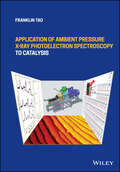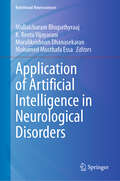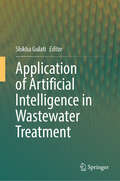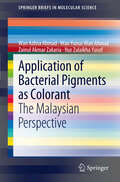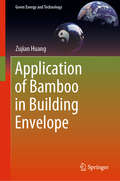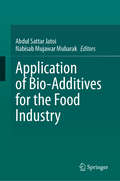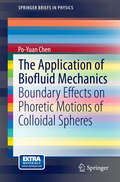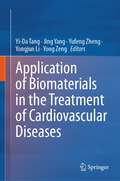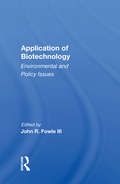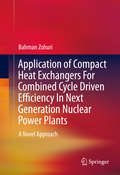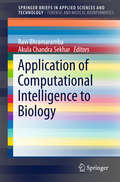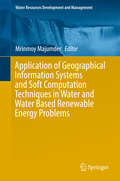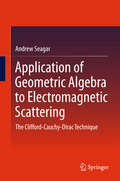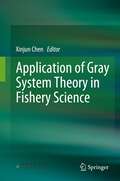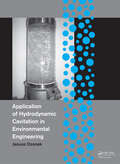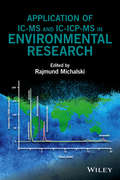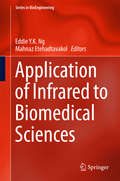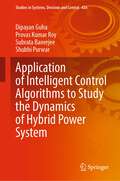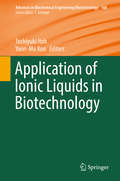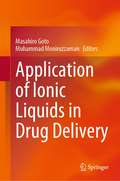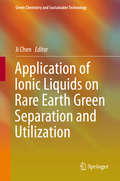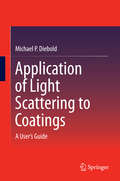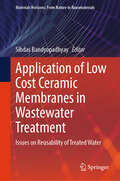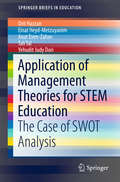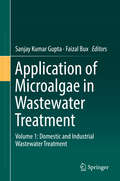- Table View
- List View
Application of Ambient Pressure X-ray Photoelectron Spectroscopy to Catalysis
by Franklin TaoAPPLICATION OF AMBIENT PRESSURE X-RAY PHOTOELECTRON SPECTROSCOPY TO CATALYSIS Authoritative and detailed reference on ambient-pressure x-ray photoelectron spectroscopy for practitioners and researchers starting in the field Application of Ambient Pressure X-ray Photoelectron Spectroscopy to Catalysis introduces a relatively new analytical method and its applications to chemistry, energy, environmental, and materials sciences, particularly the field of heterogeneous catalysis, covering its background and historical development, its principles, the instrumentation required to use it, analysis of data collected with it, and the challenges it faces. The features of this method are described early in the text; the starting chapters provide a base for understanding how AP-XPS tracks crucial information in terms of the surface of a catalyst during catalysis. The second half of this book delves into the specific applications of AP-XPS to fundamental studies of different catalytic reactions. In later chapters, the focus is on how AP-XPS could provide key information toward understanding catalytic mechanisms. To aid in reader comprehension, the takeaways of each chapter are underlined. In Application of Ambient Pressure X-ray Photoelectron Spectroscopy to Catalysis, readers can expect to find detailed information on specific topics such as: Going from surface of model catalyst in UHV to surface of nanoparticle catalyst during catalysis Application of XPS from surface in UHV to surface in gas or liquid phase and fundamentals of X-ray spectroscopy Significance and challenges of studying surface of a catalyst in gaseous phase and instrumentation of ambient pressure X-ray photoelectron spectrometers Experimental methods of AP-XPS studies and difference in data analysis between AP-XPS and high vacuum XPS Ambient Pressure X-Ray Photoelectron Spectroscopy is an ideal resource for entry level researchers and students involved in x-ray photoelectron spectroscopy. Additionally, the text will appeal to scientists in more senior roles in academic and government laboratory institutions in the fields of chemistry, chemical engineering, energy science, and materials science.
Application of Artificial Intelligence in Neurological Disorders (Nutritional Neurosciences)
by Muralikrishnan Dhanasekaran Mullaicharam Bhupathyraaj K. Reeta Vijayarani Mohamed Musthafa EssaThis book discusses the role of artificial intelligence in neurological disorders, including, alleviating movement disorders, psychiatric disorders, diagnosis of neurological and neurodegenerative disorders, dementia, neuronal cancer, neuronal Infections, and brain diseases. It explores applications of artificial intelligence in the early diagnosis, prognosis, and development of new therapies against neurodegenerative disorders. This book also provides cutting-edge research using AI for studying neuroimage analysis, toward the discovery of new biological pathways and systems implicated in dementia and related diseases. It also reviews AI-based interventions in depression research and treatment. The chapter also examines the potential benefits of using AI to help manage depression, from improved access to coordinated care. This book is an essential source for students, researchers, academicians, and neurologists aiming to understand AI-based approaches for the diagnosis, treatment, and prevention of neurological disorders.
Application of Artificial Intelligence in Wastewater Treatment
by Shikha GulatiThis book offers a comprehensive exploration of the integration of artificial intelligence (AI) techniques in addressing challenges and optimizing processes within wastewater treatment. The coverage of the book spans a spectrum of applications, including AI-driven monitoring and control systems, predictive modeling for pollutant removal, and the development of smart sensor networks for real-time data analysis in wastewater treatment plants. By amalgamating AI methodologies with wastewater treatment processes, the book provides insights into enhancing efficiency, reducing costs, and mitigating environmental impacts. In the current research scenario, the theme of the book is highly pertinent as it responds to the pressing need for sustainable and efficient wastewater treatment solutions. The book defines the theme by elucidating how AI technologies, such as machine learning algorithms and data analytics, can revolutionize wastewater treatment processes by enabling proactive decision-making, optimizing resource allocation, and predicting potential system failures. This intersection of AI and wastewater treatment not only addresses operational challenges but also contributes to the broader goal of achieving environmentally conscious and economically viable solutions.
Application of Bacterial Pigments as Colorant: The Malaysian Perspective (SpringerBriefs in Molecular Science)
by Wan Yunus Wan Ahmad Wan Azlina Ahmad Zainul Akmar Zakaria Nur Zulaikha YusofEnvironmental concerns regarding continuous use of synthetic dyes saw a revival in the demand for natural dyes as natural dyes exhibit better biodegradability and generally have a higher compatibility with the environment. However, one of the limitations on the use of natural dyes or pigments is the low extraction yield factors (a few grams of pigment per kg of dried raw material). Therefore, the exploitation of other biological sources such as fungi, bacteria and cell cultures offers interesting alternative. Microbial pigments such as from bacterial origins offer the advantage in terms of production compared to pigments extracted from vegetables or animals, due to its simple cell and fast culturing technique. This book offers interesting insight into initial works carried out to demonstrate the potential use of bacterial pigment as colorant for various applications.
Application of Bamboo in Building Envelope (Green Energy and Technology)
by Zujian HuangThis book offers a comprehensive overview of the use of bamboo in building industry. It systematically demonstrates bamboo’s utility in terms of its properties, describing the material properties of typical industrial bamboo products, and discussing their performance evaluation and optimization as building components and in the creation of building envelopes. The book also includes examples of the high-value utilization of bamboo forest resources. Further, it examines how building performance may be affected by conditions such as climate. Including insights from material science, construction design, building physics and building climatology, the book also provides data obtained from technology and market status investigation, laboratory test and the computer simulation.This book appeals to scientists and professionals, as it introduces and tests various bamboo products, demonstrating the advantages and disadvantages for each one. The book is also a valuable resource for civil engineers and students interested in this unique plant material and its application in the building industry.
Application of Bio-Additives for the Food Industry
by Abdul Sattar Jatoi Nabisab Mujawar MubarakThis text provides advanced and comprehensive information related to food additives based on bio-sources. A thorough overview of the many groups of microorganisms used as food additives is presented, as well as all of their main characteristics. The chapters give a step-by-step description of bio based food additives, including substances that are employed commercially by manufacturers as enzymes, antioxidants, stabilizers, emulsifiers, organic acids, colorants, sweeteners, and flavorings. Additionally, each chapter places a focus on the usage of probiotics and enzymes as examples of microbes used as medicinal agents. In its examination of the food additive lists for food products for the manufacture of nourishing and safe food, Application of Bio-Additives for the Food Industry offers a thorough, updated overview of food bio-additives that can be utilized by food scientists, nutritionists, microbiologists and more.
The Application of Biofluid Mechanics
by Po-Yuan Chen"The Application of Biofluid Mechanics: Boundary Effects on Phoretic Motions of Colloidal Spheres" focuses on the phoretic motion behavior of various micron- to nanometer-size particles. The content of this book is divided into two parts: one on the concentration gradient-driven diffusiophoresis and osmophoresis, and one on thermocapillary motion and thermophoretic motion driven by temperature gradient. Diffusiophoresis and osmophoresis are mainly used in biomedical engineering applications, such as drug delivery, purification, and the description of the behavior of the immune system; thermocapillary motion and thermophoretic motion are applied in the field of semiconductors as well as in suspended impurities removal. The book also provides a variety of computer programming source codes compiled using Fortran for researchers' future applications. This book is intended for chemical engineers, biomedical engineers and scientists, biophysicists and fundamental chemotaxis researchers. Dr. Po-Yuan Chen is an Assistant Professor at the Department of Biological Science and Technology, China Medical University, Taichung, Taiwan.
Application of Biomaterials in the Treatment of Cardiovascular Diseases
by Yi-Da Tang Jing Yang Yufeng Zheng Yongjun Li Yong ZengThis book summarizes the recent advancements for biomaterials in the field of cardiovascular disease, including drug delivery system (gene, protein, drug), implant interventional instrument (heart valve, heart blocker, stent, artificial blood vessel, patch, artificial heart, cardiac pacemaker, etc.) have been innovated and applied to the clinical uses to treatment of cardiovascular disease. Through the summary of this book, readers will have comprehensive and advanced understanding of the application of biomaterials in the field of cardiovascular disease.
Application Of Biotechnology: Environmental And Policy Issues
by John R. FowleThis book provides the technical background and a historical perspective of biotechnology. It examines scientific questions on the assessment of risk for the release of genetically engineered organisms into the environment and describes the role of individuals to foster industrial growth.
Application of Compact Heat Exchangers For Combined Cycle Driven Efficiency In Next Generation Nuclear Power Plants: A Novel Approach
by Bahman ZohuriCovers the fundamentals of combined-cycle plants to provide background for understanding the progressive design approaches at the heart of the text Discusses the types of compact heat exchanger surfaces, suggesting novel designs that can be considered for optimal cost effectiveness and maximum energy production Undertakes the thermal analysis of these compact heat exchangers throughout the life cycle, from the design perspective through operational and safety assurance stages This book describes the quest to create novel designs for compact heat exchangers in support of emergent combined cycle nuclear plants. The text opens with a concise explanation of the fundamentals of combined cycles, describing their efficiency impacts on electrical power generation systems. It then covers the implementation of these principles in nuclear reactor power systems, focusing on the role of compact heat exchangers in the combined cycle loop and applying them to the challenges facing actual nuclear power systems. The various types of compact heat exchanger surfaces and designs are given thorough consideration before the author turns his attention to discussing current and projected reactor systems, and how the novel design of these compact heat e xchangers can be applied to innovative designs, operation and safety analyses to optimize thermal efficiency. The book is written at an undergraduate level, but will be useful to practicing engineers and scientists as well.
Application of Computational Intelligence to Biology (SpringerBriefs in Applied Sciences and Technology)
by Ravi Bhramaramba Akula Chandra SekharThis book is a contribution of translational and allied research to the proceedings of the International Conference on Computational Intelligence and Soft Computing. It explains how various computational intelligence techniques can be applied to investigate various biological problems. It is a good read for Research Scholars, Engineers, Medical Doctors and Bioinformatics researchers.
Application of Geographical Information Systems and Soft Computation Techniques in Water and Water Based Renewable Energy Problems (Water Resources Development and Management)
by Mrinmoy MajumderThis book highlights the application of Geographical Information System (GIS) and nature based algorithms to solve the problems of water and water based renewable energy resources. The irregularity in availability of resources and inefficiency in utilization of the available resources has reduced the potentiality of water and water based renewable energy resources. In recent years various soft computation methods (SCM) along with GIS were adopted to solve critical problems. The book collects various studies where many SCMs were used along with GIS to provide a solution for optimal utilization of natural resources for satisfying the basic needs of the population as well as fulfilling their burgeoning energy demands. The articles depict innovative application of soft computation techniques to identify the root cause and to mitigate the uncertainty for optimal utilization of the available water resources. The advantage of SCM and GIS were used to maximize the utilization of water resources under cost and time constraints in face of climatic abnormalities and effect of rapid urbanization.
Application of Geometric Algebra to Electromagnetic Scattering: The Clifford-Cauchy-Dirac Technique
by Andrew SeagarThis work presents the Clifford-Cauchy-Dirac (CCD) technique for solving problems involving the scattering of electromagnetic radiation from materials of all kinds. It allows anyone who is interested to master techniques that lead to simpler and more efficient solutions to problems of electromagnetic scattering than are currently in use. The technique is formulated in terms of the Cauchy kernel, single integrals, Clifford algebra and a whole-field approach. This is in contrast to many conventional techniques that are formulated in terms of Green's functions, double integrals, vector calculus and the combined field integral equation (CFIE). Whereas these conventional techniques lead to an implementation using the method of moments (MoM), the CCD technique is implemented as alternating projections onto convex sets in a Banach space. The ultimate outcome is an integral formulation that lends itself to a more direct and efficient solution than conventionally is the case, and applies without exception to all types of materials. On any particular machine, it results in either a faster solution for a given problem or the ability to solve problems of greater complexity. The Clifford-Cauchy-Dirac technique offers very real and significant advantages in uniformity, complexity, speed, storage, stability, consistency and accuracy.
Application of Gray System Theory in Fishery Science
by Xinjun ChenThis book reviews the gray system and combines its latest research results in fishery science. The chapters cover the basic concept and theory of gray system, original data processing and gray sequence generation, gray correlation analysis, gray cluster analysis, gray system modeling, gray prediction, gray decision-making, and gray linear programming. The theory of gray system is a new cross-sectional discipline founded in 1982 by Professor Deng Julong, a well-known scholar in China. In recent decades, it has not only been deepened and expanded in theory but also widely used in the fields of society, economy, ocean, agriculture, fishery, and other fields, and made a series of significant scientific achievements. These have laid the foundation for the important position of the gray system theory. Due to the great uncertainty of the fishery resources and the fishery environment involved in the fishery science system, which is completely different from the natural resources on the land, the data and information belong to the category of “poor information”, and the variability and uncertainty are greater than other natural resources. As an extremely effective analytical method and tool, gray system theory has been applied increasingly in fishery science. The book is developed based on well-read and practical literature and will help scientists and research units engaged in scientific research and teaching in fishery science and related fields to develop new research methods and tools.
Application of Hydrodynamic Cavitation in Environmental Engineering
by Janusz OzonekContaining the state-of-the-art in hydrodynamic cavitation, the book consists of two parts. The first part presents the physical basis of cavitation and a systematic classification of various kinds of cavitation and their formation sources. Special attention is paid to a group of factors that promote cavitation formation in natural liquids. A gener
Application of IC-MS and IC-ICP-MS in Environmental Research
by Rajmund MichalskiIntroduces the reader to the field of ion chromatography, species analysis and hyphenated methods IC-MS and IC-ICP-MS including the theory and theirs applications Covers the importance of species analysis and hyphenated methods in ion chromatography Includes practical applications of IC-MS and IC-ICP-MS in environmental analysis Details sample preparation methods for ion chromatography Discusses hyphenated methods IC-MS and IC-ICP-MS used in determining both the total element contents and its elements Details speciation analysis used in studying biochemical cycles of selected chemical compounds; determining toxicity and ecotoxicity of elements; food and pharmaceuticals quality control; and in technological process control and clinical analytics
Application of Infrared to Biomedical Sciences (Series in BioEngineering)
by Eddie Y. K. Ng Mahnaz EtehadtavakolThe book covers the latest updates in the application of infrared to biomedical sciences, a non-invasive, contactless, safe and easy approach imaging of skin and tissue temperatures. Its diagnostic procedure allows practitioners to identify the locations of abnormal chemical and blood vessel activity such as angiogenesis in body tissue. Its non-invasive approach works by applying the technology of the infrared camera and state-of-the-art software, where high-resolution digital infrared imaging technology benefits highly from enhanced image production, standardized image interpretation protocols, computerized comparison and storage, and sophisticated image enhancement and analysis. The book contains contributions from global prominent scientists in the area of infrared applications in biomedical studies. The target audience includes academics, practitioners, clinicians and students working in the area of infrared imaging in biomedicine.
Application of Intelligent Control Algorithms to Study the Dynamics of Hybrid Power System (Studies in Systems, Decision and Control #426)
by Dipayan Guha Provas Kumar Roy Subrata Banerjee Shubhi PurwarThis book aims to systematically review and design different intelligent control algorithms for the small-signal stability assessment of HPS. With the growing consciousness of global warming and the fast depletion of natural power generation resources, the existing power system is on the verge of transitions to a “hybrid power system (HPS)” integrated with distributed energy resources. The recent results and requirements for the developments of intelligent control algorithms have motivated the authors to introduce this book for extensively analyzing the performance of HPS against unknown/uncertain disturbances. This book introduces fractional-order resilient control methodologies for arresting small-signal instability of HPS. The prospective investigation has been performed on the MATLAB platform. This book is helpful for undergraduate, postgraduate students, and research scholars working in power system stability, control applications, and soft computing in particular.
Application of Ionic Liquids in Biotechnology (Advances in Biochemical Engineering/Biotechnology #168)
by Toshiyuki Itoh Yoon-Mo KooThis volume explores how ionic liquids are used in different areas of biotechnology. It also provides insights on the interaction of ionic liquids with biomolecules and biomaterials. Ionic liquids have become essential players in the fields of synthesis, catalysis, extraction and electrochemistry, and their unique properties have opened a wide range of applications in biotechnology. Readers will discover diverse examples of the application of ionic liquids as solvents for biomaterials extraction and pretreatment, in enzymatic and whole cell catalysed reaction, and as activation agents for biocatalysis. Particular attention is given to the biologically functionalized ionic liquids employed in medical and pharmaceutical applications. Although ionic liquids are considered “green solvents”, the contributing authors will also explore their environmental impact when applied to biotechnology. Chemical, biological and medical scientists interested in ionic liquids and biotechnology will find this work instructive and informative.
Application of Ionic Liquids in Drug Delivery
by Masahiro Goto Muhammad MoniruzzamanThis book presents recent advances in the use of ionic liquids in medicine and pharmaceutics with particular emphasis on addressing critical pharmaceutical challenges, including the low solubility, polymorphism, and bioavailability of drugs. It also provides insights into the development of the biologically functionalized ionic liquids suitable for medical and pharmaceutical applications. Ionic liquids have been used as potential solvents or materials in the fields of pharmaceutical drug delivery and formulations because of their unique and tunable physicochemical and biological properties. Readers find explanations of the diverse approaches to the application of ionic liquids in drug solubility, active pharmaceutical ingredient (API) formulation, and drug delivery systems, such as topical, transdermal, and oral delivery, with particular emphasis on recent developments. Particular attention is given to the development of ionic liquid-assisted effective drug delivery techniques for sparingly soluble or insoluble drug molecules. This book also discusses the biological activities of ionic liquids for possible applications in drug formulation and drug delivery systems. Scientists in disciplines such as chemistry, biology, and pharmaceutics find this book instructive and informative for developing ionic liquid-based drug formulations or drug delivery systems.
Application of Ionic Liquids on Rare Earth Green Separation and Utilization (Green Chemistry and Sustainable Technology)
by Ji ChenThis book comprehensively details the applications of ionic liquids in rare earth green separation and utilization based on the unique interactions of ionic liquids with rare earth ions. It consists of nine chapters demonstrating the synthesis and properties of ionic liquids, coordination chemistry of ionic liquids and rare earth, ionic liquids as diluents, extractants, adsorption resins for rare earth extraction and separation, electrodeposition of rare earth metals in ionic liquids, and preparation of rare earth material with the aid of ionic liquids. It is both interesting and useful to chemists, metallurgists and graduate students working on fundamental research of ionic liquids as well as professionals in the rare earth industry. It provides considerable insights into green chemistry and sustainable processes for rare earth separation in order to meet the environmental challenge of rare earth metallurgy around the globe, especially in China. Ji Chen is a Professor of Chemistry at the Changchun Institute of Applied Chemistry, Chinese Academy of Sciences, China.
Application of Light Scattering to Coatings: A User’s Guide
by Michael P. DieboldThe book begins with the fundamentals of light scattering, first by individual particles, then by small groups of particles, and finally by the trillions of particles present in a real-life paint film. From there, Dr. Diebold focuses on application of these fundamentals to paint formulation. The scope includes both theory and practice with an emphasis on application (from both performance and cost standpoints). The book gives a clear understanding of light scattering principles and application of these principles to paint formulation (with a focus on TiO2 - the strongest scattering material available to paint formulators). The reader will be in a position to formulate and reformulate paints for maximum cost effectiveness. Application of Light Scattering to Coatings: A Users Guide is ideal for a range of professions working in paint formulation and manufacturing. This book also: Distills difficult theories (light scattering, paint formulation) into easy-to-understand concepts Adopts a qualitative perspective, with minimal use of complex equations, making key scientific concepts accessible to all paint formulators without a prerequisite of higher mathematics Offers an accessible resource for formulators new to the field while maintaining a high degree of relevance to experienced coating formulators Discusses the interplay between resin, TiO2 pigments, and paint extenders with regard to paint performance and cost Presents an unbiased assessment of opacifying potential of TiO2 alternatives Outlines strategies for minimizing overall costs of paints.
Application of Low Cost Ceramic Membranes in Wastewater Treatment: Issues on Reusability of Treated Water (Materials Horizons: From Nature to Nanomaterials)
by Sibdas BandyopadhyayThis book reviews the status of developing tailor-made low-cost membranes and membrane-based separation processes for applications in wastewater treatment. It also presents an overview of industry-specific case studies upholding the waste-to-resource strategy for utilization of low-cost ceramic membranes in industrial wastewater treatment. This book highlights methods, results, and examples demonstrating that low-cost ceramic membranes possess similar features and advantages comparable to the commercially available ceramic membranes, thereby minimizing the prohibitive cost of their usage in wastewater treatment. Thus, the readers who are looking for more economical alternatives for wastewater treatment can be introduced with the cheaper membrane materials. It also discusses the selection and method of application of such membranes in the treatment processes. This book can serve as a valuable reference for researchers and professionals interested in wastewater treatment and allied fields.
Application of Management Theories for STEM Education: The Case of SWOT Analysis (SpringerBriefs in Education)
by Orit Hazzan Einat Heyd-Metzuyanim Yehudit Judy Dori Anat Even-Zahav Tali TalThis work describes the application of management theories in STEM (Science, Technology, Engineering and Mathematics) education systems. Two chapters examine STEM education on the K-12 national level and one chapter focuses on the higher education institutional level. All chapters are based on comprehensive research. Thus, it will appeal to teachers, school principals, researchers, graduate students, government policymakers, and all practitioners who care about STEM education in schools, academia and government. In each chapter, SWOT (Strengths, Weaknesses, Opportunities, and Threats) analysis is used as a managerial strategic tool for the examination of factors that focus either on internal circumstances (strengths and weaknesses), or external ones (opportunities and threats).
Application of Microalgae in Wastewater Treatment: Volume 1: Domestic and Industrial Wastewater Treatment
by Faizal Bux Sanjay Kumar GuptaThis two-volume work presents comprehensive, accurate information on the present status and contemporary development in phycoremediation of various types of domestic and industrial wastewaters. The volume covers a mechanistic understanding of microalgae based treatment of wastewaters, including current challenges in the treatment of various organic and inorganic pollutants, and future opportunities of bioremediation of wastewater and industrial effluents on an algal platform. The editors compile the work of authors from around the globe, providing insight on key issues and state-of-the-art developments in algal bioremediation that is missing from the currently available body of literature. The volume hopes to serve as a much needed resource for professors, researchers and scientists interested in microalgae applications for wastewater treatment. Volume 1 focuses on the different aspects of domestic and industrial wastewater treatment by microalgae. The case studies include examples such as genetic technologies as well as the development and efficient use of designer consortia for enhanced utilization of microalgae. This volume provides thorough and comprehensive information on removal of persistent and highly toxic contaminants such as heavy metals, organic pesticides, polyaromatic hydrocarbons, endocrine disruptors, pharmaceutical compounds, and dyes from wastewater by microalgae, diatoms, and blue-green algae. Design considerations for algal ponds and efficient use of photobioreactors and HRAPs for wastewater treatment are some other highlights. This volume addresses the applications, potentials, and future opportunities for these various considerations in water pollution mitigation using algal technologies.
